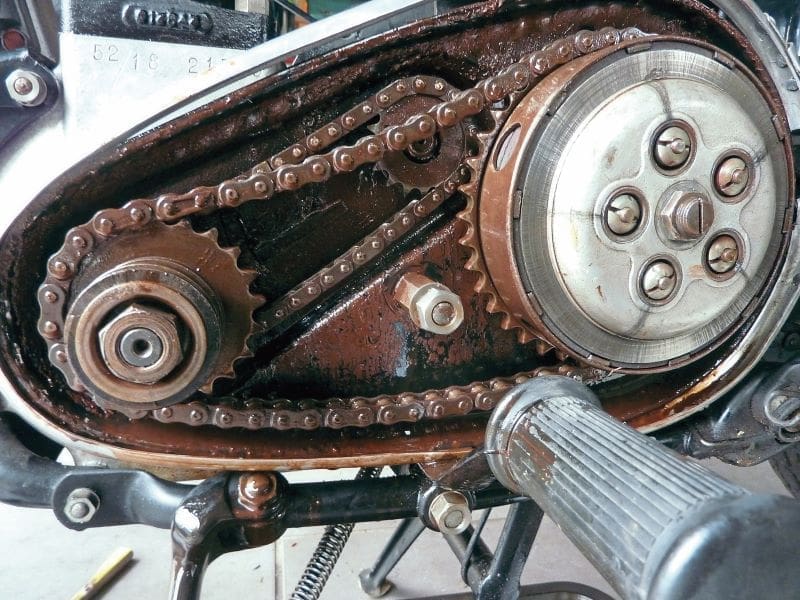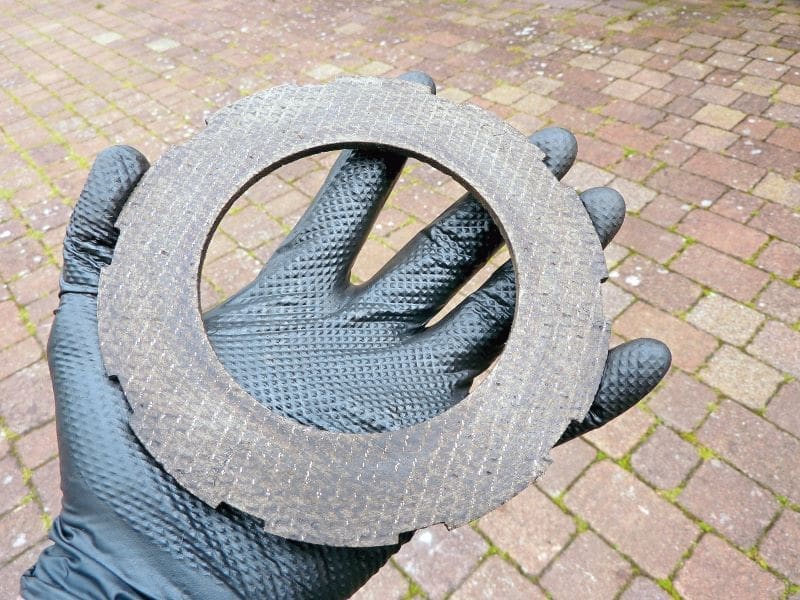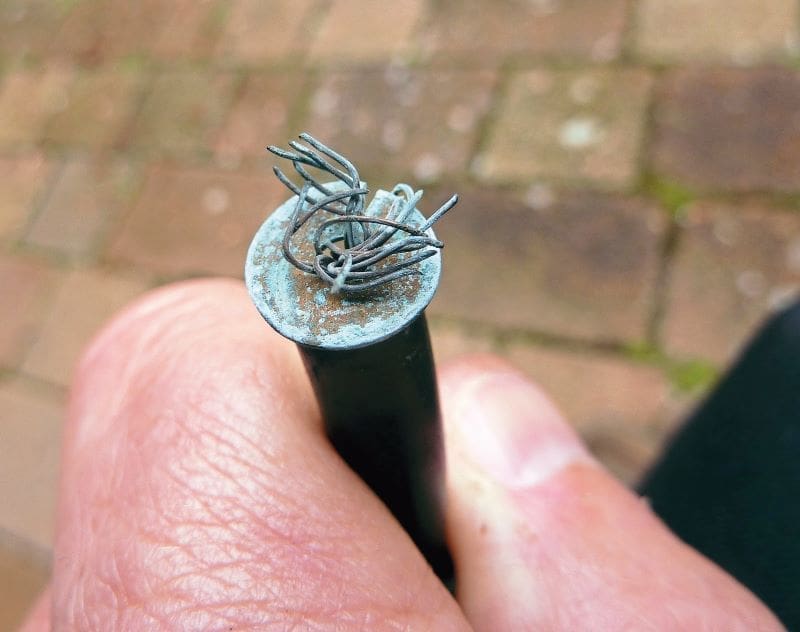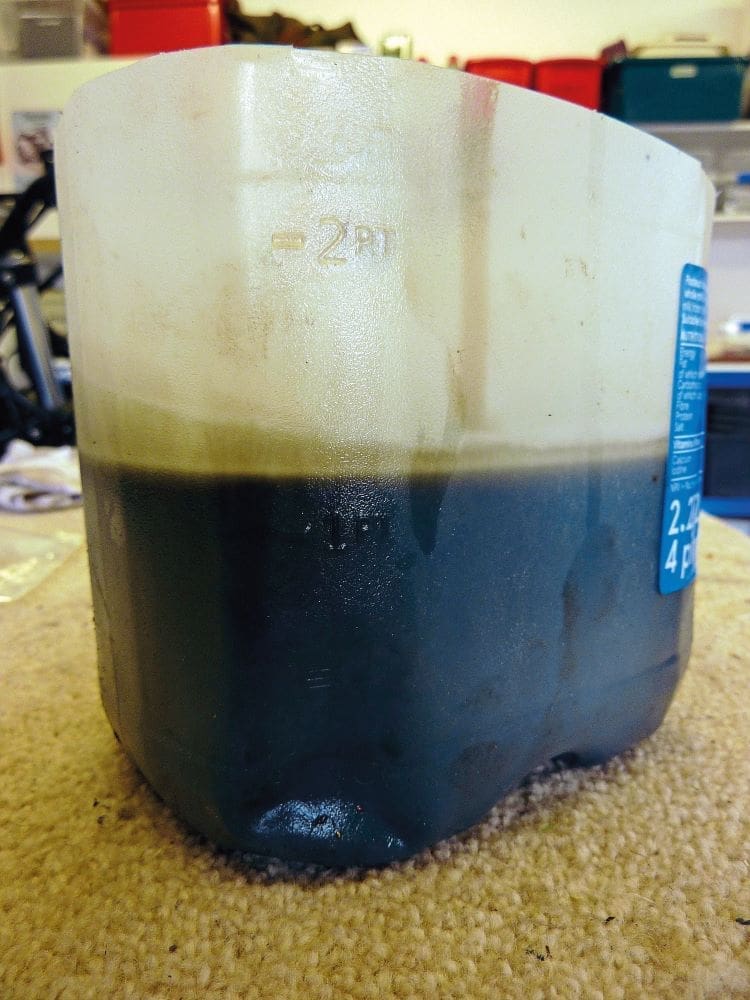Would you take back an ex? Stuart Urquhart, Classic Bike Guide’s finder and reporter of fine Scottish classics, bumps into his old AJS Model 18 and takes it home. But not all that glitters is gold…

Written and photographed by Stuart Urquhart
Requiring no introduction to classic enthusiasts, this AJS single is a great-looking motorcycle – one of the best and deserving of ‘a class of its own,’ some might say, especially if you were me. Sadly, I’ve owned three on separate occasions down the years. I say sadly because, from Rigid to Jampot, I fell headlong for every model, and yet I sold each one on. Predictably, I was seduced on each occasion by another must-have classic. What follows is a love story with a happy ending (aren’t they all?) because as luck would have it, I was afforded the opportunity of winning back my dearly-departed old flame. Apologies should this story sound more like a Mills & Boon romance than a CBG feature, but as I’ve openly confessed, I’m hopelessly besotted by AMC singles.
I can only thank SCMC member George Kerr for sending me down the road to buying back my old AJS Model 18S. I restored 739 YUA in 2010, after which it featured in Real Classic. I then sold it to George years later. But In April this year during a catch-up chat with George, I learned he’d sold my old Jampot to his friend and local artist Ron Lawson. My ears perked up when I learned that Ron had never used the Model 18, even though it had been in his ownership for eight long years – how amazing! George also hinted that Ron might let it go to the right buyer, and naturally I considered myself qualified, so I decided to find out more.
Now follows a long detective story made short. George said he would send on Ron’s contact details, but this unfortunately didn’t happen. Still frustrated months later, I searched online for ‘Ron Lawson artist’ and my efforts were rewarded with ‘Ron Lawson Dundee Art Gallery,’ to which I pinged a ‘please get in touch!’ email. Attached were my credentials (i.e., I restored your lovely AJS) and a PDF of the Real Classic feature. Several weeks later, a very polite email from Ron popped up on my PC: ‘If you would you like to see your lovely old AJS again, please get in touch.’

Consequently, I found myself admiring my old AJS 500. I was surprised to learn that Ron had bought it in fond memory of his father, as had I. Ron explained that as a young schoolboy, he enjoyed Sunday rides with his dad on an AJS combination. He can also remember admiring the beautiful styling of the many AJS and Matchless singles his father had owned and cherished. Ron then confided that his AJS was purchased ‘solely as a reminder of the good old days’ and not to ride. In fact, it has never been fired up or turned a wheel. Obviously, I was astonished.
Also obvious was that my old Ajay had been cherished and looked very much as I remembered. When Ron politely asked if I would like to offer it a new home, I nearly bit his hand off! But I suspect we both knew the underlying reason for my visit, and following some friendly negotiation and a short haggle, we eagerly shook hands.
Almost immediately, Ron invited me to fire up the AJS. I knew from experience that this would be better attempted when I had the bike back at home – especially considering its long years of hibernation. Ron’s jovial prompting, however, had me stepping onto the podium and turning on the fuel tap. I tickled the carb, quietly accompanied by some grumblings concerning old fuel. Next I set the advance and retard lever halfway and similarly the choke. I pulled in the clutch and gave the kick-start a few good dibs to free off the plates in time-honoured fashion. Then I pulled in the valve-lifter and gently turned the engine over a several times, praying that the magneto would spark (no tools to check the plug). Just a smidgen past compression (TDC), I released the valve-lifter and brought all my weight down on the kick-start, but the engine was locked solid (of course, classic enthusiasts will guess why).
After a round of guffaws, followed by a few limp excuses, I repeated the clutch spinning technique before nudging the piston over compression, courtesy of the handy valve-lifter. My second attempt was an embarrassing repeat of the first. But on the third stroke, and with the valve-lifter fully open, I kicked again and was rewarded with a submissive backfire – but a sudden and violent kick-back locked my leg. This hurt like hell, though I didn’t admit this to Ron or the foul-tempered AJS. With a burning thigh and tiring fast, I again kicked for dear life, determined to let Ron hear his AJS rumble for possibly the first and last time. It eventually fired up, ticked over nicely for several seconds, and abruptly died as soon as I attempted to open the throttle. I gave up, suspicious of a drowned sump and the possibility of hydraulic seizure. I had hoped of returning ‘tooled up’ on another day and successfully riding the AJS back home, but this was never going to happen. I handed Ron a cheque, we shook hands once more, and I turned for home to await my cheque clearing.





Fettling a laid-up classic
Weeks later, and with the AJS back home, my first task was to empty the wet-sumped engine. I was astonished to relieve the crank of just over one pint of black, putrid oil – no surprise, then, that the engine had struggled to run. Next, I drained the oil tank to remove a cracked and leaking rubber pipe that supplied oil to the engine. Unfortunately, its inline gauze filter was damaged too. Another problem surfaced when I removed the upper large felt filter from the oil tank’s top, which I discovered was also damaged and misaligned with its top-hat washer, cap and inner seat, so I decided it would be prudent to renew the lot.
Also requiring attention was a weeping oil leak from both the oil pump’s feed and return covers. Fortunately, I have a gasket tool set complete with a stack of graded papers, so making new cover gaskets to stem the leaks was a doddle. A lucky escape was deciding to flush out the oil tank, as out swished globs of old silicone, a few gasket remnants and a wayward nut!
Hiding behind the oil tank I found a nest of broken wires that were carelessly wrapped in insulating tape – certainly not previous work of yours truly! With a growing list of nagging problems, I knew a comprehensive service was the best and only solution.
With the battery no longer present, its carrier was removed to access the nest of broken wires. Exposed ends were simply tidied and ‘crimped’ with new bullets – an important task to help protect the dynamo and control box, should they still be functioning. A hold-up was the wait for new oil lines, filters and seals from AMC Spares, but a productive evening was spent cleaning and polishing both wheels and spokes with wire wool and petrol; they came up very well indeed.
Several days later the ignition system was given a thorough inspection. First up was to remove the magneto cover, beneath which I discovered a set of oiled-up points. A good clean with white spirit, then a follow-up polish with a fine magneto file had the points ready for action. I also reset the points-gap from a very tight 6-thou to the correct 12-thou. I had no need to worry about upsetting the ignition timing, as adjustment of the magneto’s advance and retard lever will take care of any incremental changes I’d made to the points.






Next, the HT cable was checked for continuity, and once removed I noted the pick-up end’s copper washer was green with oxidisation. The washer was removed, scrubbed and polished. Before reattaching the cleaned washer, it’s vitally important to trim back the HT cable until bright new copper contact wires are exposed. Another source of ‘lost sparks’ and often overlooked is a dirty Lucas HT cable pick-up (attached to the magneto); the inner contact should be methodically cleaned with an ear-bud doused in petrol or white spirit – mine was especially grubby.
Inlet and exhaust tappets were checked and proved fine – in fact, much as I’d set them in 2011 – perhaps further confirmation of the Ajay’s infrequent use? Turning to the carburettor, I unscrewed the bottom drain plug, followed by the main and pilot jet, but found nothing of concern – no dirt, detritus or water blobs were present. Final job was to check and adjust the clutch and front brake cables.
I was now ready to attempt starting the Ajay’s 500cc engine. The choke lever was set fully-on, and the handlebar advance and retard lever to half-advance. The carb I gently flooded before engaging the valve-lifter to effortlessly turn the engine over TDC and ‘prime’ the engine. With a fistful of throttle I kicked hard, but immediately the engine backfired. In response, I backed off the choke and retarded the ignition and was immediately rewarded when the engine burst into life on the second attempt. As the engine warmed, there was no worrying exhaust smoke or unusual mechanical noises. It was time for a shakedown run.
Togs and hat on, I was soon rumbling around our local back roads. The bike responded very well, without any mechanical grumblings or bits flying off – I was, however, startled by a flock of low-flying Kamikaze ducks! On the return journey, an annoying ‘knock’ came from both Jampots (the name given to rear shocks found on AMC machines for those not familiar and great for their time – Matt) every time we encountered a pothole. I concluded that the aftermarket Rockshock dampers I’d fitted back in 2011 had lost their damping and could do with a service, but this was sidelined for the winter.




We take the high road
“Let’s go a run to the Glen Clova Hotel,” suggested my biking buddies Ian and Mike. At close to a 50-mile round trip, this would prove a fitting test for my fettled AJS. But would I live to regret their enthusiastic offer?
As I lived within easy striking distance of the splendid Angus Glens (in the Eastern Highlands), we met at mine and thundered there via local country roads (Mike’s Matchless G80 provided the thunder!). On reaching Glen Clova, we stopped at the tourist car park to indulge in a quick stretch and a discussion about which road we’d take to the hotel – the choice being a high, winding mountain road with crazy bends and ‘bums off seats’ scenery or the equally scenic low road that meanders along the lazy River Esk.
But thoughts of lunch and a tasty pint in the summer sunshine quickly evaporated when I couldn’t restart my AJS. I was shocked, being unfamiliar with a perfectly running motorcycle that suddenly refused to start. After my ‘kicking’ leg tired, Mike had a go on fresh pins; alas, Mike too had no luck in firing up the sulking beast. Plug removed, we tried the old trick of pouring fuel down the bore as we kicked the wheezing machine in turns – harrah for Mike, who eventually brought her back to life.
“Right, engines on,” he bellowed, and we rumbled north, up and down, and round and round the high road leading to the Glen Clova Hotel. My hankering for a refreshingly cold beer was dashed for a second time when bar staff informed us they couldn’t serve us until midday – we were 45 minutes early. With a visible slump, we reluctantly settled for coffee and cake and shuffled outside to discuss homeward-bound tactics, lest another non-starting debacle should hamper our progress.


Fortunately, the engine fired on the second kick. However, as we accelerated along the hilly road, I noticed the telltale rise and fall of a slipping clutch in top. I remember woefully thinking, ‘Whatever next?’ so I kept the revs down and gently nursed the bike home.
As I wheeled the AJS into the garage, I noticed a bubbling oil leak oozing from the base of the exhaust pushrod tunnel. Investigating further, I managed to spin the leaking tunnel just by light finger pressure alone, which didn’t seem right. My educated guess was that the bottom rubber seal must have expired. Cursing more bad luck, I then noticed a rivulet of oil oozing down the side of the oil tank from what appeared to be a loose cap, or perhaps a faulty cap seal. Another irritating source of the Ajay’s incontinence, the notorious primary side’s tin covers were already emptying their contents onto the garage floor. Presented with so many oil leaks, plus a badly-slipping clutch, I knew I was looking at another major strip-down.
The clutch, primary drive, cylinder head and barrel would all require to be removed. Following earlier discussions with Mike, I also favoured running the AJS with the dynamo disconnected. I never use the lights, and the close proximity of the contra-rotating dynamo and primary chains are a known cause of catastrophic failure within the primary drive. Another growing irritation was a ‘grabby’ and squeaking front brake, also requiring urgent attention, so for peace of mind I began stripping the AJS for the second time, or third actually – if I include its restoration back in 2010.
Much later, when removing the fuel tank, I noticed that one missing rear fixing bolt had made an impromptu escape somewhere up in the wilds of Glen Clova. However, I was well practiced with tank and seat removal, and both came off in minutes, as did the battery box and the rear brake lever. But then I was immediately stumped when attempting to remove the primary side footrest, along with the outer primary chaincase cover. Forgotten was the footrest’s ‘locked-in’ location between the lower frame rail and rear engine plate, making it, and the outer primary cover, ridiculously difficult to remove.
I was now facing more work and hassle just to sort a few oil leaks and a slipping clutch. I retired under a dark cloud… with no idea that my problems were about to double overnight.
The constant oil leaks from the primary chaincase, plus a slipping clutch, persuaded me to try and run the primary drive ‘dry.’ Not best practice, I’ll be the first to admit; however, if I could set up the outer case to be easily removed, then a regular ‘oil and grease’ service should suffice in the lubrication stakes, especially given I was only intending to use the AJS at local events or on low-mileage country runs.
Along with a slipping clutch, the run to Glen Clova revealed a spell of poor starting after the AJS had reached working temperature. I was certain this wasn’t due to the well-documented phenomenon ‘hot mag syndrome,’ principally because the magneto was professionally overhauled during the 2010 restoration. Since it had barely turned a wheel since, I deduced some further ignition and carburetion detective work might highlight other problems I may have overlooked. I decided to tackle the primary drive side problem first…
Next day I began to dismantle the primary drive, now covered in unsightly oil. Quite obvious was that the rubber sealing band that sits between the alloy clamping strap and both inner and outer chaincase halves had failed. Frustratingly, after removing the chaincase central retaining nut, both the outer case and alloy strap refused to budge. Not until the rubber sealing band was laboriously cut piece by piece and pulled away in chunks was there any perceptible movement. As deduced, the ‘jam’ was caused by the footrest being positioned tight up against the chaincase. This suggested that the AJS had toppled over at some point, resulting in a bent footrest – easy to imagine when trying to haul this heavyweight beast onto its centrestand!
After loosening the footrest spindle and both nuts, the outer case was eventually wiggled free, but the alloy retaining strap remained stubbornly locked to the inner cover’s lower lip and ‘bent’ footrest. Removal was a fretful and irksome fight, and in pursuit of much simpler reassembly, I would need to come up with a better and more effective solution.
The engine sprocket was whipped off, followed by the clutch and primary chain. Next, the ‘problem’ dynamo sprocket and chain were disposed with, courtesy of a mini-puller. Then a bad-tempered hour was spent attempting to move the trapped and bent footrest and spindle just to create room to remove the alloy retaining strap with the inner chaincase. The lack of free movement is caused by both footrest and spindle having a spline fit, thus both parts are locked in position.





By contrast, the troublesome clutch jumped off (in fright, I assume) when I swore after accidentally bashing my knuckles – the result of a slipping spanner. But the wily old AJS had the last laugh (and me on all fours) when it spat out the clutch basket’s rollers in several directions across the garage floor. Once removed from their ‘basket,’ the fibre clutch plates looked in fairly good nick. As a ‘belt and braces,’ I cleaned them with petrol and steel wool, and after offering up a prayer to the AMC gods, I hoped the addition of new clutch springs would help to cure the slipping plates.
I was determined to run the troublesome primary cases ‘dry,’ but pay frequent attention to oiling the engine shock-absorber and primary chain. To achieve this, I extended the inner cover’s mounting slots to allow more flexibility in removal and fitting. This one task gobbled up an afternoon of patient testing and refitting the primary case assembly before I had achieved a stress-free working system I was happy with – now minus its dynamo and troublesome chain, of course!
Turning to the leaking pushrod tubes, I indulged in a simple experimental ‘bench test.’ I added the rubber seals and washers before pushing each vertical tube in turn against the work bench, while at the same time observing if the bottom washers compressed and formed a tight seal. Unfortunately, the test demonstrated that the bottommost washer disappeared up inside its tube, allowing the tube’s metal base to make contact with the wooden bench. Clearly, not an effective seal! New tubes and seals joined my shopping list.
Next was remove the front wheel and ‘centralise’ the squeaking brake shoes as recommended in the factory manual. Essentially, this is a multi-task operation performed as follows: grip the wheel and spindle in a vice; slacken off both the brake’s centre hub nut and the offset fulcrum nut; apply the brake full-on using a tube spanner to add extra leverage to the brake arm; then retighten both the aforementioned nuts before relaxing the brake arm pressure (phew!). Hopefully, the next shakedown run will be enjoyed without the irritation of a squeaky front brake.
Groundhog Day once again, stripping and carefully inspecting the carb, but no dirt, jet blockage or other problems were found. During the ‘Clova run,’ a rear fuel tank mounting bolt had gone AWOL. Unfortunately, I discovered the tank thread was stripped when I attempted to insert a new mounting stud. Instead I decided to ‘glue’ the stud in place until I could carry out a proper repair this coming winter.
Soon parts arrived from AMC Classic Spares, and I was able to rebuild the top end with new pushrod tubes, rubber seals and a copper head gasket. The new tubes turned out to be 5mm too long, preventing the cylinder head from connecting with the barrel. When I called Steve at AMC, he confirmed the tubes were the correct length for my ’52 model. His expert opinion was that my machine was fitted with a barrel from an earlier model – shorter to allow for the fitment of a ‘compression plate.’ I reverted to the original and shorter pushrod tubes and was delighted when they fitted fine.
I reset the tappets before attempting to replace the fuel tank – which refused to go back on! Perplexed, I soon discovered the glued-in studs were too long and obstructed the tank from slipping into its rear mounts; this in turn caused the fuel tank to clash with the handlebar mounting clamp. Both clamp and handlebars would now require to be removed before the fuel tank could be fitted to the bike. Mugged, I had to walk away and rethink this frustrating problem over a calming cuppa… we’ve all been there.
Next day, the fuel tank was handed over to Engine Resource (Engineers) of Dundee to have both rear threads renewed and thus allow assembly using the correct detachable bolts, as opposed to my glued-in stud bodge. Meantime, the gearbox end cover was removed and rebuilt with new kick-start and gear lever seals to hopefully stem two more annoying oil leaks. With the end cover back in place and new oil added, I woke up the following morning to a dry garage floor for the first time since the AJS and I were reunited.
My last job was to find a solution to the Ajay’s hot-starting problem – hopefully, simple detective work.

My transformed 18S
After I’d undertaken the ignition/carb detective work above, there didn’t appear to be any obvious reason for my Ajay’s hot-starting problem, so on went the repaired fuel tank and in went a new spark plug. Following a ten-mile run I was thrilled when everything behaved as normal. Today, even when at working temperature, the AJS starts first time, every kick – what is it with classic bikes?
There’s not much more I can say about this old and charming motorcycle other than I find the ride utterly engaging and totally rewarding. I love its muted yet confident exhaust note. I love the docile and biddable motor. I actually love the temperamental Burman gearbox that demands nothing less than slow and practiced gear changes.
Thankfully, my recent fettling would seem to have paid dividends – the pushrod covers and gearbox appear to be oil-tight (thus far) and the brakes have lost their irritating squeak. More rewarding is the clutch is behaving as a good clutch should, even when gunned in top gear during a testing climb up the steepest gradients within the Fife Alps. But disappointing is that the primary case still weeps. Whether this is due to my exuberant over-lubrication (now that the primary side is running dry) or the result of a leaking crankcase/gearbox oil seal, only time will tell. But I suspect I’m far too handy with my oil can.
A welcome return is the Model 18’s beating heart. I seem to have introduced a wonderful and metronomic tickover at some point during my fettling, but I don’t know when or how. Instead, I kid myself on that I’ve won back my old flame’s heart!
Whatever, being a spectacular and good-looking classic, she’s the envy of several friends and will definitely be staying put with me. So far, the AJS is performing well and living up to its reputation as a charming and dependable workhorse. It is commonly said that ‘love is blind.’ I say love is a black and gold Model 18.
Ignition and carburetion fault-finding
Many will be familiar with prepping a laid-up classic for a return to the road. For those wishing to have a go, here are a few fault-finding tips and procedures that have worked for me in reviving old classics, especially those afflicted with the common ailment of ‘difficult starting.’ These handy tips apply to most British bikes – singles or twins reliant on magneto and points ignition and fitted with single or twin carburettors (Amal Monobloc or Concentric carbs).
First check is to verify that the spark plug gap is correct, and that the plug’s overall condition is satisfactory. If reusing an old plug, clean the plug electrode with petrol/white spirit, then follow-up with emery paper to remove any burnt-on carbon. However, it is preferable renew old plugs, especially on classics that have been stored and unused with modern petrol. Setting the plug electrode gap according to the manual is crucial, as is fitting the correct grade and recommended make of sparkplug.
Another crucial check is the magneto points gap and similarly, checking the ignition timing which determines when the plug spark ignites fuel during the engine’s compression stroke – a necessary task if the timing has been disturbed (again, refer to your manual). Once the magneto’s points gap has been correctly set, it is imperative to check they open just before TDC (top dead centre). All classic motorcycles have different settings for this, so refer to a manual. This task is made easier by selecting third gear and moving the piston to TDC by turning the rear wheel by hand, while at the same time observing the piston rising through its compression stroke. To accurately measure the piston’s position, use a TDC indicator tool designed to replace the spark plug (or a long and thick cable tie placed inside the bore can work as a makeshift indicator – never use a screwdriver which can jam and damage the rising piston). Machines fitted with a magneto advance and retard lever should generally start when the lever is set ‘retarded’ – too much advance will result in a vicious ‘backfire’ and a potentially violent kick-back of the kick-start lever, so be warned!
Next task is checking over the carburettor. Begin by verifying that the airscrew is the correct number of turns out; normally, this is set one and a half turns from being fully closed. Also remove the float bowl’s drain plug and check/remove any tank rust, debris or water. Next, remove the lower brass main jet and upper needle jet to blow/clean out any dirt. Debris can be removed with a cotton bud soaked in petrol but avoid using a wire probe which can easily damage a jet’s bore. Check the jet needle is rising and falling and is clipped in the correct position (usually the centremost groove). Raising the needle above centre position enriches the fuel mixture and lowering weakens it.
The spark plug is an excellent indicator of correct fuel mixture. A white electrode is indicative of a weak mixture, while a sooty/black deposit tells you the carb is delivering too rich a mixture. Chocolate-brown on the electrode with black around the plug base is a good sign the fuel mixture is correct. Oily can point to worn rings – don’t read that as rich mixture.
Twin carbs are treated much as above, except they will need careful ‘balancing’ or synchronisation of each individual throttle slide/valve. This is best achieved by tweaking the top cap setting screws on each carb. The object is to set both individual throttle slides so each rise and fall together, as if a pair. It is vitally important to back-off both tick-over screws before attempting to set and balance throttle slides. If you can’t observe the throttle slides, try using a mirror with a torch.
Some ‘cafe racers’ will vouch for a twin carb set-up; twin carbs, however, do require regular overhauls to keep them tuned and performing well. Many classic riders will confirm a single carburettor spells peace of mind!




